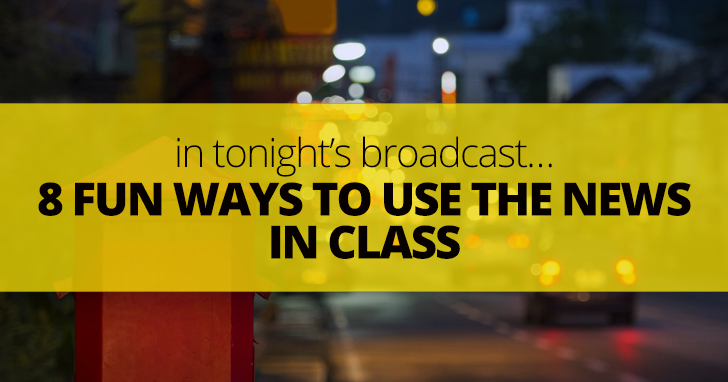In Tonight’s Broadcast…8 Fun Ways to Use the News in Class


Television programs also provide students with realistic conversation and dialogues, which aid listening skills by offering a diverse range of accents for the students to hear. Another advantage is that the majority of TV programs use relatively simple language; otherwise they provide the viewers with a clear explanation.
Television can be used in a number of ways to add that all-important element of depth to your class. Here’s a few of our favourites.
Entertain
Ah, yes. Entertainment. Where would we be without it? And especially television. Well, just like we get bored with monotonous things, our students do as well. So in order to give them a short break from books, grammar and structures, television programs work a treat. However, teachers shouldn’t use this as an excuse to be lazy: even entertainment lessons, for example, at the end of a course, should contain a worksheet or simple task to go along with it.
Best TV programs – Any appropriate movie or a TV episode that fits well into the class.
Improve Listening Skills
50 percent of TV involves us listening to it, so why not leave the 15 year old cassette player in the teachers’ room, and bring in a DVD to add a little variety to your class. Even preparation for IELTS and TOEFL classes can benefit from watching an appropriate TV show in class. Teachers simply have to create a worksheet containing questions in the style of TOEFL or IELTS that relate to the content. One TV show that I like to use with these classes, and can be used with practically any class is Man Vs Wild. Man Vs Wild makes for a great classroom activity, and will have the students sitting on the edge of their seat. It’s even better to see their faces when he eats a worm or a frog.
Best TV programs – Man Vs Wild, Air Crash Investigation, House MD.
Learn About Culture With News
I am a strong believer that classes should not just be about English, but also contain elements of cultural tid bits that the students use if they travel overseas at a later date. One quick and easy way to gain a deep insight into various cultures around the world is through an ordinary nightly news bulletin from any commercial broadcaster. Commercial broadcasters are ideal as they aim to appeal to the masses, maintaining a simple level of language and popular stories.
Best TV programs – Any news bulletin from BBC, CNN or Al Jazeera, or for a laugh, try Fox News.
Introduce Assignment Work
Keeping the class up to date on current affairs of the world is fun for me, as a news junkie, while offering variety for the students. BBC News offers a very short news program called ‘Around the World in 80 Seconds’, which provides brief snippets of news from around the world. I like to use this as an introduction to assignment work on world news. Students will watch the broadcast two or three times while taking notes. They can then pick one of the issues heard in the broadcast to research and write about, handing it in the following week. While not only improving their English skills, it also prepares students with some of the research that they may have to undertake at university.
Best TV Program to use – BBC’s Around the World in 80 Seconds.
“Learn English” TV Programs
If you feel that you’re students may be more responsive to a TV than you, simply let the TV do all the work! Well, not really, use it sparingly as a tool to maintain a good mix of variety. While it’s not as interactive as a teacher, it can provide some very good examples. I have found myself trying to explain a point, and later seen it in a “learn English” TV show explained with succinct explanations and easy-to-understand examples. These are a good way to complement what the students learn in class while providing a mix of accents and voices that provide enough variety for the students to practice.
Best TV Program to use – There’s so many out there, but I find ‘Australia Network’ to have the most comprehensive range of “Learn To Speak English”-style programs, including ‘Study English’, ‘English Bytes’, and much more. ‘Australia Network’ also features one of the best IELTS tips programs of anywhere I have seen. IELTS teachers should take a look at “Study English - IELTS Preparation 1 & 2”.
A Visual Explanation
If a picture tells a thousand words, then obviously a video must tell a whole lot more! Television programs can provide a detailed explanation on topics that can be quite difficult to explain. Some localised sports, such as cricket or curling can be an incredibly difficult for an ESL student to comprehend, which is where visual aids, such as videos, come in amazingly handy.
As a teacher, you will benefit as well. Most TV programs and activities that work well can be re-used over and over as you teach new classes.